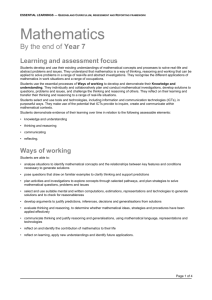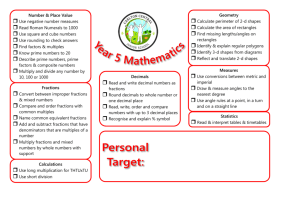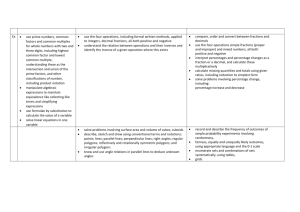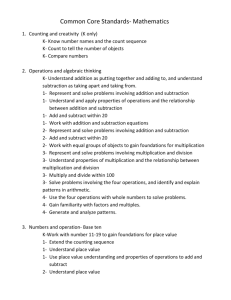By the end of Year 7 - Queensland Curriculum and Assessment
advertisement
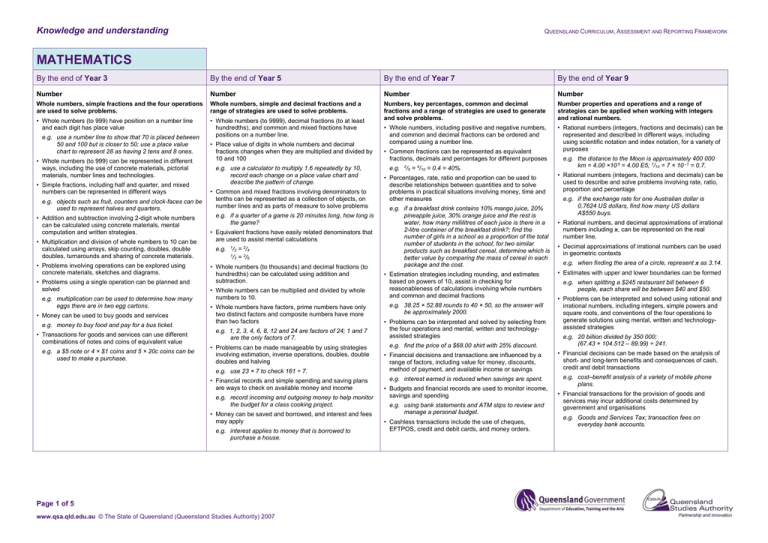
Knowledge and understanding QUEENSLAND CURRICULUM, ASSESSMENT AND REPORTING FRAMEWORK MATHEMATICS By the end of Year 3 By the end of Year 5 By the end of Year 7 By the end of Year 9 Number Number Number Number Whole numbers, simple fractions and the four operations are used to solve problems. Whole numbers, simple and decimal fractions and a range of strategies are used to solve problems. • Whole numbers (to 999) have position on a number line and each digit has place value • Whole numbers (to 9999), decimal fractions (to at least hundredths), and common and mixed fractions have positions on a number line. Numbers, key percentages, common and decimal fractions and a range of strategies are used to generate and solve problems. Number properties and operations and a range of strategies can be applied when working with integers and rational numbers. • Whole numbers, including positive and negative numbers, and common and decimal fractions can be ordered and compared using a number line. • Rational numbers (integers, fractions and decimals) can be represented and described in different ways, including using scientific notation and index notation, for a variety of purposes e.g. use a number line to show that 70 is placed between 50 and 100 but is closer to 50; use a place value chart to represent 28 as having 2 tens and 8 ones. • Whole numbers (to 999) can be represented in different ways, including the use of concrete materials, pictorial materials, number lines and technologies. • Simple fractions, including half and quarter, and mixed numbers can be represented in different ways e.g. objects such as fruit, counters and clock-faces can be used to represent halves and quarters. • Addition and subtraction involving 2-digit whole numbers can be calculated using concrete materials, mental computation and written strategies. • Multiplication and division of whole numbers to 10 can be calculated using arrays, skip counting, doubles, double doubles, turnarounds and sharing of concrete materials. • Problems involving operations can be explored using concrete materials, sketches and diagrams. • Problems using a single operation can be planned and solved e.g. multiplication can be used to determine how many eggs there are in two egg cartons. • Money can be used to buy goods and services e.g. money to buy food and pay for a bus ticket. • Transactions for goods and services can use different combinations of notes and coins of equivalent value e.g. a $5 note or 4 × $1 coins and 5 × 20c coins can be used to make a purchase. • Place value of digits in whole numbers and decimal fractions changes when they are multiplied and divided by 10 and 100 e.g. use a calculator to multiply 1.6 repeatedly by 10, record each change on a place value chart and describe the pattern of change. • Common and mixed fractions involving denominators to tenths can be represented as a collection of objects, on number lines and as parts of measure to solve problems e.g. if a quarter of a game is 20 minutes long, how long is the game? • Equivalent fractions have easily related denominators that are used to assist mental calculations e.g. 1 1 /2 = 2 /4 /3 = 2 /6 • Whole numbers (to thousands) and decimal fractions (to hundredths) can be calculated using addition and subtraction. • Whole numbers can be multiplied and divided by whole numbers to 10. • Whole numbers have factors, prime numbers have only two distinct factors and composite numbers have more than two factors e.g. 1, 2, 3, 4, 6, 8, 12 and 24 are factors of 24; 1 and 7 are the only factors of 7. • Problems can be made manageable by using strategies involving estimation, inverse operations, doubles, double doubles and halving e.g. use 23 × 7 to check 161 ÷ 7. • Financial records and simple spending and saving plans are ways to check on available money and income e.g. record incoming and outgoing money to help monitor the budget for a class cooking project. • Money can be saved and borrowed, and interest and fees may apply e.g. interest applies to money that is borrowed to purchase a house. Page 1 of 5 www.qsa.qld.edu.au © The State of Queensland (Queensland Studies Authority) 2007 • Common fractions can be represented as equivalent fractions, decimals and percentages for different purposes e.g. 2 4 /5 = /10 = 0.4 = 40%. • Percentages, rate, ratio and proportion can be used to describe relationships between quantities and to solve problems in practical situations involving money, time and other measures e.g. if a breakfast drink contains 10% mango juice, 20% pineapple juice, 30% orange juice and the rest is water, how many millilitres of each juice is there in a 2-litre container of the breakfast drink?; find the number of girls in a school as a proportion of the total number of students in the school; for two similar products such as breakfast cereal, determine which is better value by comparing the mass of cereal in each package and the cost. • Estimation strategies including rounding, and estimates based on powers of 10, assist in checking for reasonableness of calculations involving whole numbers and common and decimal fractions e.g. 38.25 × 52.88 rounds to 40 × 50, so the answer will be approximately 2000. • Problems can be interpreted and solved by selecting from the four operations and mental, written and technologyassisted strategies e.g. find the price of a $68.00 shirt with 25% discount. • Financial decisions and transactions are influenced by a range of factors, including value for money, discounts, method of payment, and available income or savings e.g. interest earned is reduced when savings are spent. • Budgets and financial records are used to monitor income, savings and spending e.g. using bank statements and ATM slips to review and manage a personal budget. • Cashless transactions include the use of cheques, EFTPOS, credit and debit cards, and money orders. e.g. the distance to the Moon is approximately 400 000 km = 4.00 ×10 5 = 4.00 E5; 7/10 = 7 × 10 –1 = 0.7. • Rational numbers (integers, fractions and decimals) can be used to describe and solve problems involving rate, ratio, proportion and percentage e.g. if the exchange rate for one Australian dollar is 0.7624 US dollars, find how many US dollars A$550 buys. • Rational numbers, and decimal approximations of irrational numbers including π, can be represented on the real number line. • Decimal approximations of irrational numbers can be used in geometric contexts e.g. when finding the area of a circle, represent π as 3.14. • Estimates with upper and lower boundaries can be formed e.g. when splitting a $245 restaurant bill between 6 people, each share will be between $40 and $50. • Problems can be interpreted and solved using rational and irrational numbers, including integers, simple powers and square roots, and conventions of the four operations to generate solutions using mental, written and technologyassisted strategies e.g. 20 billion divided by 350 000; (67.43 + 104.512 – 89.99) ÷ 241. • Financial decisions can be made based on the analysis of short- and long-term benefits and consequences of cash, credit and debit transactions e.g. cost–benefit analysis of a variety of mobile phone plans. • Financial transactions for the provision of goods and services may incur additional costs determined by government and organisations e.g. Goods and Services Tax; transaction fees on everyday bank accounts. Knowledge and understanding QUEENSLAND CURRICULUM, ASSESSMENT AND REPORTING FRAMEWORK MATHEMATICS By the end of Year 3 By the end of Year 5 By the end of Year 7 By the end of Year 9 Algebra Algebra Algebra Algebra Relationships between objects or numbers can be described using patterns and simple rules. Patterns and relationships can be identified, described and applied with the conventions of the four operations. Algebraic expressions and equations can be applied to describe equivalence and solve problems. • Simple relationships between objects or numbers can be described in terms of order, sequence and arrangement • Simple relationships are used to predict results of change • Expressions and relationships, including formulas and simple equations, can be demonstrated using words, diagrams, materials and symbols to represent variables Variables, algebraic expressions and equations, relationships and functions can be described, represented and interpreted. e.g. plot the hourly temperature during the day on a simple scale and observe that it rises between 8 in the morning and 12 midday, then stays the same until school finishes for the day. • Simple relationships between objects or numbers, including equivalence, can be represented using concrete and pictorial materials e.g. 14 + 8 can be changed to 12 + 10 without affecting the equivalence; objects can be used to show the equivalence of number expressions such as 5 + 6, 9 + 2 and 3 + 4 + 4. • Inverse relationships between addition and subtraction can be applied to find unknowns and maintain equivalence in equations e.g. + 3 = 7, 4 = 7 – 3; 7 + 4 = 6 + 5. • Number patterns and sequences based on simple rules involve repetition, order and regular increases or decreases e.g. changes in perimeter occur when the length of the sides increases. • Patterns in space and number, and relationships between quantities, including equivalence, can be represented using concrete and pictorial materials, lists, tables and graphs e.g. represent the relationship between side and perimeter of squares in tables, pictures and graphs. • Rules can be developed to interpret a pattern and predict further elements e.g. identify the relationship between the numbers 0, 1, 1, 2, 3, 5, 8 in order to continue the sequence. • Generalisations associated with the four operations are built upon commutative, associative and distributive properties and inverse operations e.g. commutative: 7 × 4 × 5 is the same as 4 × 5 × 7 associative: 2 × (3 × 4) is the same as (2 × 3) × 4 distributive: 2(3 + 4) is the same as 2 × 3 + 2 × 4 inverse: 23 × 7 is used to check 161 ÷ 7. e.g. identify and continue the pattern in 2, 5, 8, 11 ... e.g. relate the expression “the perimeter of a rectangle is equal to twice its length plus twice its width” to the corresponding diagram and the formulas perimeter = 2 × length + 2 × width or p = 2 × l + 2 × w; find the perimeter of a rectangle with length 8 cm and width 5 cm. • Equations and expressions involving addition, subtraction and multiplication can be solved to establish equivalence e.g. use materials, diagrams and number examples to explain why (2 × 6) + (3 × 6) = 5 × 6 and generalises to (2 × n) + (3 × n) = 5 × n. • The order of operations identifies the appropriate sequence of operations used in calculations to obtain solutions e.g. the order of operations is applied to solve 5 + 4 × 6 = 29. • Tables of values for functions using input–output rules can be constructed and the resulting ordered pairs graphed e.g. use a rule that explains the relationship between pairs of terms in a sequence to calculate the value of the 12th term of the sequence. • Variables and constants are represented using words and symbols when writing expressions and equations e.g. V = π r 2h where V is the volume of a cylinder in m 3, r is the radius in m, and h is the height in m. • Algebraic relationships can be modelled, interpreted and evaluated using integer, decimal and fraction values of variables e.g. explore the relationship between area, width and length of a rectangle where the area equals 100 cm 2. • Inverse, associative, commutative and distributive properties can be used to manipulate and rearrange algebraic expressions that involve the four operations, reciprocals, whole-number powers and square roots e.g. rearrange p = 3q – 2 to obtain q = (p + 2) 3 • Linear and some non-linear equations related to real-life problems can be represented and solved using a variety of methods e.g. find the time taken to travel 300 km at an average speed of 85 km/h; determine the approximate dimensions of a rectangle with area 100 cm 2, width w and length 3 cm greater than its width. • Tables of values constructed for linear and simple nonlinear functions can be graphed e.g. tables of values for the relationship vt = 6, where v represents the average speed in km/h and t represents the time travelled in hours, are constructed and graphed. Page 2 of 5 www.qsa.qld.edu.au © The State of Queensland (Queensland Studies Authority) 2008 Knowledge and understanding QUEENSLAND CURRICULUM, ASSESSMENT AND REPORTING FRAMEWORK MATHEMATICS By the end of Year 3 By the end of Year 5 By the end of Year 7 By the end of Year 9 Measurement Measurement Measurement Measurement Unique attributes of shapes, objects and time can be identified and described using standard and nonstandard units. Length, area, volume, mass, time and angles can be estimated, measured and ordered, using standard and non-standard units of measure. Units of measure, instruments, formulas and strategies can be used to estimate and calculate measurement and consider reasonable error. • Hour, half-hour and quarter-hour times and five-minute intervals are read using analogue clocks and all times are read using digital clocks. • Analogue and digital clocks can be used to read time to the nearest minute. Relationships between units of measure and the attributes of length, area, volume, mass, time and angles are used to calculate measures that may contain some error. • Calendars can be used to identify specific information about days and dates e.g. identify the dates of every Tuesday in a month; identify the date that is a week later or earlier than a given date. • Standard units, including centimetre, metre, kilogram (half and quarter) and litre (half and quarter), and non-standard units of measurement can be used to measure attributes of shapes and objects e.g. centimetres and hand span may both be used to measure the length of a desktop. • Measurements of length, area, volume and mass of shapes and objects are compared and ordered, using instruments e.g. use scales to compare the mass of a range of objects; use a one-litre measuring jug to fill and compare the volumes of other containers. • Timelines, clocks, calendars and timetables are used to sequence, schedule and calculate timed events e.g. use a calendar to calculate the number of school days until holidays. • Standard units, including centimetre, metre, square centimetre, square metre, gram, kilogram, minute, degree, millilitre and litre, and a range of instruments are used to measure and order attributes of objects, including length, area, volume, mass, time, and angles e.g. use a protractor to measure the angles within a triangle. • Links exist between different ways of recording the same measurement e.g. 100 cm = 1 m, 1000 mm = 1 m. • Reasonable estimates can be made using strategies that suit the situation e.g. stepping out a backyard cricket pitch; applying a 1 cm grid to estimate area of a square. • Timetables and duration of events involving both 12- and 24-hour time cycles and Australian time zones can be calculated e.g. calculate the length of a flight between the east and west coast of Australia, taking into account the time difference. • Appropriate instruments, technologies and scale are used when exploring measurement of length, area, volume, mass, time and angles where not all of the graduations are numbered e.g. reading a speedometer between 60 km/h and 70 km/h. • Relationships exist within the International System (SI) of measures, including between mm, cm, m and km; kg and t; cm2 and m2; cm3 and m3 e.g. a load of mulch has a mass of 2500 kg = 2.5 t. • Relationships between attributes of regular 2D shapes and 3D objects can be used to develop rules that allow perimeter, area and volume to be calculated e.g. using base area height to find the volume of a triangular prism. • Measurement involves error, which can be reduced through the selection and use of appropriate instruments and technologies e.g. if several students use a stopwatch to time a 100 m race, the winner’s time is only likely to be accurate to the nearest one-tenth of a second because of different reaction times. • Estimation strategies are used to identify a reasonable range of values for a measurement e.g. the liquid left in a partially full 1 L bottle is estimated to the nearest 50 ml. Page 3 of 5 www.qsa.qld.edu.au © The State of Queensland (Queensland Studies Authority) 2008 • Instruments, technologies, strategies and formulas are used to estimate, compare and calculate measures and derived measures, including rate, area, duration and Australian time zone differences e.g. average speed in km/h to determine time needed to complete a journey. • Relationships exist between units of equivalent measure and are used to make conversions of units e.g. use 4.5 hectares instead of 45 000 m 2 to state the area of a parcel/block of land. • Lengths and angles that cannot be measured directly can be investigated using scale, similarity or trigonometry e.g. finding the height of a building using the angle of elevation and the distance to the base of the building; calculating distances from maps. • Judgments can be made about acceptable error of measurement and error can be compounded by repetition and calculation e.g. cutting three pieces of material to an accuracy of 3 mm from a single piece may give a total error of up to 9 mm; when measuring the sides of a pentagon to find its perimeter, if each measurement has a 1 mm error the perimeter calculation may be incorrect by up to 5 mm. Knowledge and understanding QUEENSLAND CURRICULUM, ASSESSMENT AND REPORTING FRAMEWORK MATHEMATICS By the end of Year 3 By the end of Year 5 By the end of Year 7 By the end of Year 9 Chance and data Chance and data Chance and data Chance and data Chance events can be explored using predictions and statements. Data can be collected, organised and explored. Chance events have a range of possible outcomes that can be described using predictions. Data can be collected to support or adjust predictions. Probability of events can be calculated from experimental data. Data can be summarised and represented to support inferences and conclusions. Judgments can be based on theoretical or experimental probability. Data can be displayed in various ways and analysed to make inferences and generalisations. • Predictions about chance events can be made using simple statements • The likelihood of outcomes of events involving chance can be described using terms including “likely”, “more likely”, “most unlikely” and “never”. • Events have different likelihoods of occurrence and estimates of probability can be expressed as percentages, common fractions or decimal fractions between 0 and 1 • Data can be gathered from samples and surveys, experiments and simulations, published data and databases, and used to estimate probabilities of events and to respond to claims and questions e.g. it is likely/unlikely that this will happen. • Data can be collected using simple surveys and observations to respond to questions e.g. survey students in class for favourite television program. • Data can be organised in lists, tables, picture graphs and bar graphs e.g. construct a bar graph of distribution of eye colour of students in the class. • Data can be explored for variation and adequacy e.g. count the number of cars outside school at drop-off and lunch times and determine if there is sufficient data or whether more should be collected. • Data collected from experiments or observations can be organised in tables and graphs and used to respond to questions about the likelihood of possible outcomes of events e.g. record 100 tosses of two dice to predict the likelihood of rolling two sixes to begin a game. • Collected data can be used to justify statements and predictions e.g. using data to justify a prediction about children’s views compared with adults’ views on the same television show. • Sets of data may contain expected or unexpected variation, and this may mean that additional data are needed e.g. variation in the time it takes to get to school during peak and off-peak times. e.g. the likelihood of drawing a red card from a 52-card pack can be represented as 50%, 1/2 or 0.5. • Experimental data for chance events can be compared with theoretical probability e.g. comparing the data gathered from tossing a six-sided dice 50 times with the theoretical probability of how many times the dice would land on a 6. • Data may be discrete and can be allocated to categories or numbered e.g. gender is a discrete variable; the numbers of male and female students in a class. • Data may be continuous and described as distributions of quantities e.g. growth of a plant; time elapsed. • Sample data drawn from a given population can be summarised, compared and represented in a variety of ways e.g. two-way tables; pie charts; bar or line graphs. • Measures of location such as mean, median and mode, and frequency and relative frequency, can be used to explore distributions of sample data e.g. the mean is the averaged daily water consumption for the school across a period of days; the median is the middle value of the ordered daily water consumption; the mode is the most common daily water consumption level; relative frequency is the chance of landing on red when using a spinner with four equal sectors that are coloured differently. • Variation and possible causes of bias can be identified in data collections e.g. the method of collection may exclude possible participants; the personal opinions of participants may obscure data collection. Page 4 of 5 www.qsa.qld.edu.au © The State of Queensland (Queensland Studies Authority) 2008 e.g. health statistics, such as the 1 in 10 chance of nonimmunised people getting influenza in a given year, can be used to predict the number of people likely to suffer from influenza in a year. • Sample spaces can be specified for single events and straightforward compound events using tables and tree diagrams, and probabilities can be determined using different methods, including counting, measuring and symmetry e.g. a grid for the scores when two six-sided dice are rolled; a tree diagram for the combination of results obtained by spinning a six-coloured spinner and tossing a coin. • Data interpretation is simplified through the use of suitable representations and descriptive statistics e.g. using two-way tables, histograms, stem and leaf plots and measures of location. • Simple measures of spread and centre, distribution of responses, and the effect of bias and outliers on the measures of location are used to make inferences e.g. the proportion of people who think the leader of a political party is doing a poor, satisfactory or good job in relation to age group can be used to make inferences about the popularity of the political party. Knowledge and understanding QUEENSLAND CURRICULUM, ASSESSMENT AND REPORTING FRAMEWORK MATHEMATICS By the end of Year 3 By the end of Year 5 By the end of Year 7 By the end of Year 9 Space Space Space Space Geometric properties can be used to describe, sort and explore 2D shapes and 3D objects. Maps and plans provide information about an environment. Geometric features are used to group shapes and guide the accuracy of representation of 2D shapes and 3D objects. Mapping conventions apply to the structure and use of maps and plans. Geometric conventions can be used to classify, represent and manipulate geometric shapes. Mapping conventions can be applied in the construction and use of maps and plans. • Geometric features, including parallel and perpendicular lines, acute, right, obtuse and reflex angles, and vertex, edge and base, can be used to sort shapes and objects into broad family groups • Geometric conventions, including length, angle size and relationships between faces, are used to classify 2D shapes and 3D objects, including part and composite shapes Geometric conventions can be used to describe, represent, construct and manipulate a range of complex geometric shapes. Mapping conventions can be used to represent location, distance and orientation in maps and plans. • Geometric names and properties are used to sort, describe and construct common 2D shapes, including squares, rectangles, triangles and circles, and 3D objects, including prisms, pyramids, cones, cylinders and spheres e.g. 3D objects can be created using modelling material; pinwheels, paper planes and flowers can be created by folding and cutting paper. • Flips, slides and turns are particular ways of moving shapes to explore symmetry e.g. complete simple visual puzzles; create repeat patterns. • Obvious features in everyday environments can be represented and located on simple maps and plans e.g. construct a map of a simple obstacle course around the school grounds. • Directions can be given for moving and for locating features within an environment e.g. instruction to move a half, full, quarter and/or threequarter turn. e.g. group quadrilaterals based on their features. • Defining features, including edges, angle sizes and parallel lines, are used to make accurate representations of 2D shapes and 3D objects. • 3D objects can be visualised or constructed using nets e.g. accurately construct a square-based or triangularbased pyramid, using a base and triangular side (lateral) faces. • Symmetry and transformations involving flips, slides, turns, enlargements and reductions provide a basis for creating patterns, designs and tessellations e.g. use of parquetry pattern in tiling. • Mapping conventions, including symbols, scales, legends and alphanumeric grids, are used to represent and interpret movements and to identify locations on maps and plans e.g. using the north symbol (↑N) and a scale of 1 cm represents 10 m on a street map. • Mapping conventions, including the four major compass points, are used to give direction and movement and can be linked to turns e.g. descriptions for locations of treasures on a “scavenger map” could include the idea that a halfturn from facing north is facing south. e.g. isosceles triangles have two equal sides and two equal base angles. • 2D shapes can be sketched or accurately represented, using drawing instruments and software, to reflect their geometric properties e.g. using a pair of compasses and a straight edge, or geometry software, to draw a plan for a kite. • 3D objects can be constructed from plans, nets and isometric diagrams e.g. constructing a model of the buildings in a street using multi-link cubes. • Congruent shapes are the same shape and size and can be superimposed on one another through a sequence of transformations, involving reflections, rotations and translations e.g. constructing a mosaic pattern from a plan drawn to scale. • Points, lines and planes of symmetry can be identified in shapes and objects and can be related to transformations and tessellations of suitable shapes in the plane e.g. the plane containing the Equator on a globe of the Earth; the application of symmetry in the construction of an origami design. • Maps and plans can be constructed and interpreted to identify a specific location, to plan movement from one location to another, and to calculate distance between locations e.g. planning a holiday route to travel from one city to another. • Mapping conventions, including coordinates, compass points and scale, are used to specify and identify locations on maps and plans e.g. applying coordinates, compass points and scale when orienteering. Page 5 of 5 www.qsa.qld.edu.au © The State of Queensland (Queensland Studies Authority) 2008 • Geometric conventions are used to describe a variety of 2D shapes and 3D objects, including curved surfaces, and compound and embedded shapes e.g. using geometric terms, the diagonals of a rhombus bisect each other at right angles; use of geometric symbols to indicate parallel, perpendicular and congruent lines. • 2D shapes and 3D objects and their cross-sections can be represented as sketches, drawings or electronic images, using specifications and conventions to identify and show geometric properties e.g. draw various cross-sections of product packaging. • 3D objects can be constructed from plans, cross-sections, nets, and isometric and perspective diagrams e.g. construct a soccer ball from a net of its stitching pattern, involving a tessellation of pentagons and hexagons. • Congruence, similarity, sequences of transformations, and symmetry are used to analyse geometric properties e.g. compare geometric properties of triangles to determine congruence or similarity. • Deductions about geometric properties can be supported by proofs related to angle properties associated with parallel, perpendicular and transverse lines and polygons e.g. when two straight lines intersect, opposite angles are equal; the sum of the interior angles of a quadrilateral with 4 sides. • Maps and plans using scale, coordinates, distance, bearing, angles, keys and annotations can be constructed and used to specify location and represent spatial relationships, as well as distance and orientation between locations e.g. orienteering or bushwalking; shortest and alternative pathways around venues such as amusement parks.

